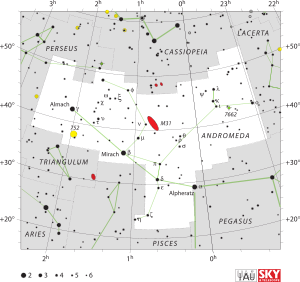Sigma Andromedae
Sigma Andromedae (σ And, σ Andromedae) is the Bayer designation for a star in the northern constellation of Andromeda. It has an apparent visual magnitude of +4.5,[2] which is bright enough to be seen with the naked eye from most locations. Parallax measurements made during the Hipparcos mission place it at a distance of about 135 light-years (41 parsecs).[1] The magnitude of the star is diminished by 0.08 from extinction caused by intervening gas and dust.[7]
 | |
| Observation data Epoch J2000.0 Equinox J2000.0 | |
|---|---|
| Constellation | Andromeda |
| Right ascension | 00h 18m 19.65745s[1] |
| Declination | +36° 47′ 06.8107″[1] |
| Apparent magnitude (V) | +4.51[2] |
| Characteristics | |
| Spectral type | A2 V[3] |
| U−B color index | +0.07[4] |
| B−V color index | +0.05[4] |
| Astrometry | |
| Radial velocity (Rv) | –8.0[2] km/s |
| Proper motion (μ) | RA: –65.67[1] mas/yr Dec.: -42.00[1] mas/yr |
| Parallax (π) | 24.20 ± 0.21[1] mas |
| Distance | 135 ± 1 ly (41.3 ± 0.4 pc) |
| Absolute magnitude (MV) | 1.33[5] |
| Details | |
| Radius | 2.1[6] R☉ |
| Luminosity | 26[7] L☉ |
| Surface gravity (log g) | 4.02[5] cgs |
| Temperature | 8,929[5] K |
| Rotational velocity (v sin i) | 123[8] km/s |
| Age | 450[9] Myr |
| Other designations | |
| Database references | |
| SIMBAD | data |
This star has a stellar classification of A2 V,[3] which matches the spectrum of an A-type main sequence star. It is about 450 million years old[9] and is spinning rapidly with a projected rotational velocity of 123 km/s.[8] The interferometry-measured angular diameter of this star is 0.465 mas,[7] which, at its estimated distance, equates to a physical radius of about 2.1 times the radius of the Sun.[6] It is radiating 26[7] times the luminosity of the Sun from its outer atmosphere at a temperature of 8,929 K,[5] giving it the white-hued glow of an A-type star.[11]
In the past, radial velocity variations have been reported, but this remains unconfirmed. The star does not show any significant photometric variations and is used as an ubvy standard star.[12] A debris disk of warm dust around this star has been detected by Spitzer Space Telescope.[13]
Sigma Andromedae is a candidate for membership in the stream of stars associated with the Ursa Major Moving Group. This is a set of stars that share a common motion through space, which suggests they originated together.[5]
Naming
In Chinese, 天廄 (Tiān Jiù), meaning Celestial Stable, refers to an asterism consisting of σ Andromedae, θ Andromedae and ρ Andromedae. Consequently, the Chinese name for σ Andromedae itself is 天廄三 (Tiān Jiù sān, English: the Third Star of Celestial Stable.)[14]
References
- van Leeuwen, F. (November 2007), "Validation of the new Hipparcos reduction", Astronomy and Astrophysics, 474 (2): 653–664, arXiv:0708.1752, Bibcode:2007A&A...474..653V, doi:10.1051/0004-6361:20078357.
- Wielen, R.; et al. (1999), "Sixth Catalogue of Fundamental Stars (FK6). Part I. Basic fundamental stars with direct solutions", Veroeffentlichungen des Astronomischen Rechen-Instituts Heidelberg, Astronomisches Rechen-Institut Heidelberg, 35 (35): 1, Bibcode:1999VeARI..35....1W.
- Cowley, A.; et al. (April 1969), "A study of the bright A stars. I. A catalogue of spectral classifications", Astronomical Journal, 74: 375–406, Bibcode:1969AJ.....74..375C, doi:10.1086/110819.
- Johnson, H. L.; et al. (1966), "UBVRIJKL photometry of the bright stars", Communications of the Lunar and Planetary Laboratory, 4 (99): 99, Bibcode:1966CoLPL...4...99J.
- King, Jeremy R.; et al. (April 2003), "Stellar Kinematic Groups. II. A Reexamination of the Membership, Activity, and Age of the Ursa Major Group", The Astronomical Journal, 125 (4): 1980–2017, Bibcode:2003AJ....125.1980K, doi:10.1086/368241.
- Lang, Kenneth R. (2006), Astrophysical formulae, Astronomy and astrophysics library, 1 (3rd ed.), Birkhäuser, ISBN 3-540-29692-1. The radius (R*) is given by:
- van Belle, G. T.; et al. (May 2008), "The Palomar Testbed Interferometer Calibrator Catalog", The Astrophysical Journal Supplement Series, 176 (1): 276–292, arXiv:0711.4194, Bibcode:2008ApJS..176..276V, doi:10.1086/526548.
- Royer, F.; Zorec, J.; Gómez, A. E. (February 2007), "Rotational velocities of A-type stars. III. Velocity distributions", Astronomy and Astrophysics, 463 (2): 671–682, arXiv:astro-ph/0610785, Bibcode:2007A&A...463..671R, doi:10.1051/0004-6361:20065224.
- Vican, Laura (June 2012), "Age Determination for 346 Nearby Stars in the Herschel DEBRIS Survey", The Astronomical Journal, 143 (6): 135, arXiv:1203.1966, Bibcode:2012AJ....143..135V, doi:10.1088/0004-6256/143/6/135.
- "sig And". SIMBAD. Centre de données astronomiques de Strasbourg. Retrieved 2012-06-24.
- "The Colour of Stars", Australia Telescope, Outreach and Education, Commonwealth Scientific and Industrial Research Organisation, December 21, 2004, retrieved 2012-06-24.
- Lehmann, H.; et al. (August 1995), "Variability investigations of possible Maia stars", Astronomy and Astrophysics, 300: 783, Bibcode:1995A&A...300..783L
- Morales, F.Y.; et al. (July 2009), "Spitzer Mid-IR Spectra of Dust Debris Around A and Late B Type Stars: Asteroid Belt Analogs and Power-Law Dust Distributions" (PDF), The Astrophysical Journal, 699 (2): 1067–1086, Bibcode:2009ApJ...699.1067M, doi:10.1088/0004-637X/699/2/1067
- (in Chinese) AEEA (Activities of Exhibition and Education in Astronomy) 天文教育資訊網 2006 年 5 月 18 日